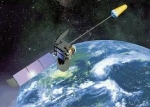Displaying items by tag: aviation control satellite
Multifunctional Transport Satellites (MTSAT)
Multifunctional Transport Satellites (MTSAT) are a series of weather and aviation control satellites.
They are geostationary satellites owned and operated by the Japanese Ministry of Land, Infrastructure and Transport and the Japan Meteorological Agency (JMA), and provide coverage for the hemisphere centred on 140° East; this includes Japan and Australia who are the principal users of the satellite imagery that MTSAT provides.
They replace the GMS-5 satellite, also known as Himawari 5. They can provide imagery in five wavelength bands — visible and four infrared, including the water vapour channel. The visible light camera has a resolution of 1 km; the infrared cameras have 4 km (resolution is lower away from the equator at 140° East). The spacecraft have a planned lifespan of five years. MTSAT-1 and 1R were built by Space Systems/Loral. MTSAT-2 was built by Mitsubishi.
- MTSAT-1R (140 ° E), also known as Himawari 6, was launched February 2005 and is now (Oct. 2013) in standby. It performed 5 years operations.
- MTSAT-2, also known as Himawari 7, successfully launched 18th February 2006, is operational since 2010 (text dated Oct. 2013).
The ground stations for both satellites are located in Kobe and Hitachiota, Japan.

